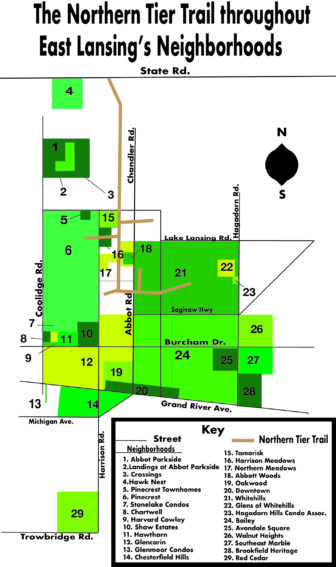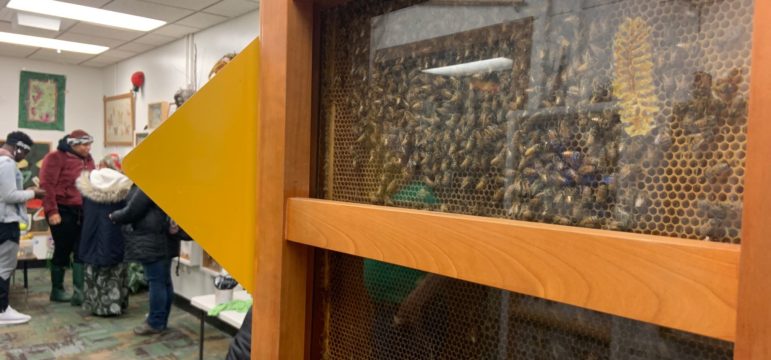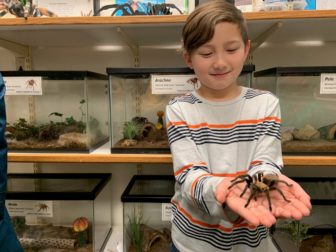East Lansing community members are calling for the extension of recreational trails for better transportation and an improved environment.
The ideas were discussed at the Parks and Recreation Department’s Plan Feb. 7 about updating its 5-year plan.
 Trail extensions and transportation were common phrases among citizens during the first half of the meeting. Citizens expressed desires for connecting trails to stores and places of work.
Trail extensions and transportation were common phrases among citizens during the first half of the meeting. Citizens expressed desires for connecting trails to stores and places of work.
Capital City Athletics Soccer coach Dan Jury of East Lansing said, “Many trails don’t end at destinations such as shopping centers and homes.”
Extending trails to businesses would allow citizens to use them for transportation. Currently, trails are seen as for recreational use only.
Pamela Weil, vice chair of the East Lansing Park and Recreations Advisory Committee, said she feels trails should be incorporated in developed areas.
“It would increase everyday use and integrate a physical lifestyle perspective rather than a fitness perspective,” said Weil.
Benefits of using trails for commuting were interactions with nature, relaxation and low costs. Disadvantages were personal, such as Jury not being able to walk to The Soccer Complex with his equipment or environmental effects such as mowing on the natural area.
Ideal trails
East Lansing’s longest trail, The Northern Tier Trail, is 4.8 kilometers and connects eight parks throughout East Lansing. Many felt The Northern Tier Trail was the ideal trail because of its length and proximity to businesses.
May Zhang of East Lansing said, “Sometimes my husband and I walk to Meijer from the trail.”
Weil also agrees with bringing the trails close to businesses. “The trail does a great job of linking to Lake Lansing Kroger and Meijer, however, you have to get on the sidewalk to complete the trip.”
Places mentioned for linking to The Northern Tier Trail were The Hannah Community Center, schools and stores. Suggestions for extending the trail were along Coolidge Road, between Hawk Island and Lake Lansing and into Lansing.
Jury said, “It would be nice if we had a trail similar to The River Trail, where I can jump on and head to the zoo or REO Town.”
Zhang also said “We often walk along The Red Cedar to downtown Lansing.”
Safety, kid-friendly, low traffic and proximity to businesses were cited as top characteristics of trails ideal l for transportation.
Tim McCaffrey, director of East Lansing’s Parks, Recreation and Arts Committee said the city has identified Lansing’s River Trail near Frandor and the underpass beneath US 127 as possible areas for the intercity connections.
East Lansing’s trails future
The Parks, Recreations, and Arts Committee is currently in the process of extending White Park Trail into The Northern Tier Trail for the 2019 fiscal year. Capital projects for fiscal years 2020 through 2024 include The Northern Tier Trail improvements from The Soccer Complex to State Road and White Park Trail improvements.
The city’s Five Year Parks and Recreation Plan expires this year, 2019. The new plan will be finalized toward the end of 2019, beginning in 2020.
“I hope they consider the trails and travel thing, it’s convenient and connects the community,” Zhang said.
Building pollinator-friendly places

Kayla Effner
A swarm of bees nestle inside their makeshift hive at the Bug House hosted by the College of Agriculture and Natural Resources. University students and East Lansing residents gathered to observe the array of organisms being displayed.

Kayla Effner
Animal-loving Oliver Hsu holds a tarantula at the Bug House. The Bug House, hosted by MSU College of Agriculture and Natural Resources, held an open house Monday, which featured a wide selection of arthropods and insects. Many of the insects Oliver and children around the world love may be at risk.
She said nature trails are not merely a place for people to run and bike, but a promising habitat for wildlife.
“The more bio-diverse it is the better off we will all be,” Biber said.
In the wake of what is known as the “sixth extinction,” insects around the world are disappearing at shocking rates. This is especially concerning when it comes to pollinators, which are responsible for the fertilization of over 80 percent of our crops.
“We want to help these insects have a place to rebound,” Biber emphasized.
A chance to be education leaders
Her sentiments led the group to discuss other possible advantages of the trails. Biber enthused about educational opportunities for children, proposing insect and plant-identifying signage be posted.
She said Pinecrest lacks hands-on education about the environment and has an abundance surrounding technology. She said it is crucial to emphasize the importance of our environment to future generations.
“If we focus on the fact that they can have an effect on life on Earth, they will see that that is important. We can change in a positive way this vision of what is progress. Not just cranes in the sky and more gadgets,” she said.
Michael Townley, a member of East Lansing’s Commission on the Environment, supported that idea.
As a college town, he explained, East Lansing has a responsibility to be a leader. Prioritizing sustainability and maintaining natural habitats are just a couple ways the city can do so.
Environmental Services Administrator Cathy DeShambo described some of East Lansing’s green ideas that are in the works.
In August 2016, the City Council passed a resolution declaring East Lansing a pollinator-friendly community. The resolution recognized the significant decrease in population and the influence humans have had on it via pesticides and destruction of habitats.
Since the resolution was passed, four demonstration pollinator gardens have been planted around the city with more to come.
“We want to encourage others to protect pollinators,” DeShambo said.